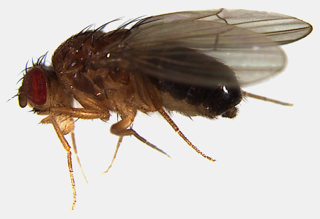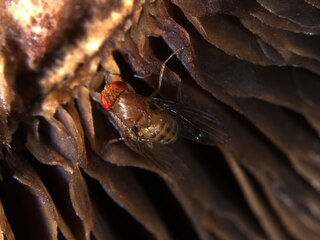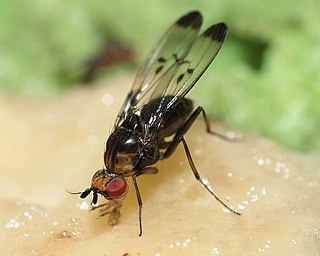
Drosophila is a genus of flies, belonging to the family Drosophilidae, whose members are often called "small fruit flies" or pomace flies, vinegar flies, or wine flies, a reference to the characteristic of many species to linger around overripe or rotting fruit. They should not be confused with the Tephritidae, a related family, which are also called fruit flies ; tephritids feed primarily on unripe or ripe fruit, with many species being regarded as destructive agricultural pests, especially the Mediterranean fruit fly.

Drosophila funebris is a species of fruit fly. It was originally described by Johan Christian Fabricius in 1787, and placed in the genus Musca but is now the type species of the paraphyletic genus Drosophila. Drosophila funebris is a member of the Immigrans-tripunctata radiation of the subgenus Drosophila.

The Drosophilinae are the largest subfamily in the Drosophilidae. The other subfamily is the Steganinae.
FlyBase is an online bioinformatics database and the primary repository of genetic and molecular data for the insect family Drosophilidae. For the most extensively studied species and model organism, Drosophila melanogaster, a wide range of data are presented in different formats.

The immigrans-tripunctata radiation is a speciose lineage of Drosophila flies, including over 300 species. The immigrans-tripunctata radiation is a sister lineage to most other members of the subgenus Drosophila. A number of species have had their genomes or transcriptomes sequenced for evolutionary studies using Drosophila.

Drosophila is a paraphyletic subgenus of the genus Drosophila, a classification of fruit flies. This subgenus was first described by Alfred Sturtevant in 1939. Members of the subgenus Drosophila can be distinguished from other Drosophilid species by breaks in the pigmentation along the dorsal section of their abdomen.

The genus Zaprionus belongs to the family fruit fly Drosophilidae and is positioned within the paraphyletic genus Drosophila. All species are easily recognized by the white longitudinal stripes across the head and thorax. The genus is subdivided in two subgenera, based on the presence of an even or odd number of white stripes. The species of the genus can be found in Africa and Southern Asia. One species, Zaprionus indianus, has invaded the New World.
The Drosophila saltans species group contains 21 described fly species, all of which are found in the neotropical region. It is one of the seven species groups in the subgenus Sophophora, the others being the D. willistoni, D. melanogaster, D. obscura, D. dispar, D. fima, and D. dentissima groups. The D. saltans species group is most closely related to the D. willistoni subgroup. The species are placed into five subgroups: the D. s. cordata, D. s. elliptica, D. s. parasaltans, D. s. saltans, and D. s. sturtevanti subgroups. It is thought that, like the D. willistoni species group, the D. saltans species group originated in tropical North America, colonized South America, and then diversified prior to the formation of the Isthmus of Panama. Some of these may have migrated back to North America within the last 4.5 million years ago (mya), and consequently the relationship between the species is unresolved due to the short amount of time that has elapsed since their divergence points.
Metavirus is a genus of viruses in the family Metaviridae. They are retrotransposons that invade a eukaryotic host genome and may only replicate once the virus has infected the host. These genetic elements exist to infect and replicate in their host genome and are derived from ancestral elements unrelated from their host. Metavirus may use several different hosts for transmission, and has been found to be transmissible through ovule and pollen of some plants.
Drosophila tripunctata is a species of vinegar fly in the Immigrans-tripunctata radiation of the subgenus Drosophila.

Drosophila immigrans is a species of vinegar fly in the family Drosophilidae. Drosophila immigrans is a member of the Immigrans-tripunctata radiation of the subgenus Drosophila. It is related to the Drosophila quinaria and Drosophila testacea species groups, and the fellow Immigrans species group member Drosophila albomicans. Drosophila immigrans has been used in evolutionary studies to understand how viruses evolve with their hosts.

The Drosophila testacea species group belongs to the Immigrans-tripunctata radiation of the subgenus Drosophila, and contains 4 species: Drosophila putrida, Drosophila neotestacea, Drosophila testacea, and Drosophila orientacea. Testacea species are specialist mushroom-feeding flies, and can metabolize toxic compounds in Amanita mushrooms. The Testacea species group is studied for its specialist ecology, population genetics, and bacterial endosymbionts. The North American species Drosophila neotestacea is perhaps the best-studied of the group for its interactions with parasitic wasps and nematodes, bacterial endosymbionts, and trypanosomatid parasites. Of note, selfish X chromosomes have been discovered in three of the four Testacea group species.
Drosophila bizonata is a species of fruit fly in the Drosophila bizonata species group in the Immigrans-tripunctata radiation of the Drosophila subgenus. Drosophila bizonata is found in Japan. D. bizonata breeds and feeds exclusively on mushrooms, and has a high tolerance for ibotenic acid, a toxic compound found in Amanita mushrooms.
The Drosophila cardini species group belongs to the subgenus Drosophila of vinegar flies in the Immigrans-tripunctata radiation of the subgenus Drosophila. The closest relatives of Cardini species include Drosophila bizonata, Drosophila quinaria, and Drosophila testacea species groups, comprising mushroom-feeding flies. Cardini group species likely derived their more general feeding ecology from a mushroom-feeding ancestor, an evolutionary transition in feeding similar to Drosophila quinaria.

Mushroom-feeding Drosophila are a subset of Drosophila flies that have highly specific mushroom-breeding ecologies. Often these flies can tolerate toxic compounds from Amanita mushrooms.
Drosophila albomicans is a species of vinegar fly in the family Drosophilidae. Drosophila albomicans is a member of the Immigrans-tripunctata radiation of the subgenus Drosophila. The D. albomicans genome was first sequenced in 2012 to study the evolution of novel sex chromosomes, a characteristic this species is best known for. One commonly accepted definition of the biological species concept is that individuals or populations are members of different species if they are incapable of successful interbreeding. While D. albomicans and Drosophila nasuta are commonly referred to as distinct species, there appears to be little to no sexual isolation between these two Drosophila species. Instead, behavioural differences appear to reproductively isolate these two species.

The Drosophila immigrans species group is a polyphyletic and speciose lineage of Drosophila flies, including over 100 species. Immigrans species belong to the Immigrans-tripunctata radiation of the subgenus Drosophila. Well-described species include Drosophila immigrans, and the sister species Drosophila albomicans and Drosophila nasuta. The genome of D. albomicans was sequenced in 2012 in an effort to characterize novel sex chromosome development in D. albomicans. Immigrans group species are related to mushroom-breeding Drosophila of the Quinaria and Testacea species groups.
Drosophila calloptera is a species of vinegar fly in the Immigrans-tripunctata radiation of the subgenus Drosophila.
The Drosophila guarani species group is a lineage of vinegar fly in the Immigrans-tripunctata radiation of the subgenus Drosophila first proposed by Dobzhansky & Pavan (1943). At least 24 species have been described, distributed throughout latin america.

The Hawaiian Drosophilidae are a lineage of flies within the genus Drosophila. This monophyletic clade includes all of the endemic Hawaiian Drosophila and all members of the genus Scaptomyza, which contains both Hawaiian and non-Hawaiian species. The Hawaiian Drosophilidae are descended from a common ancestor estimated to have lived 25 million years ago. Species of Hawaiian Drosophilidae flies have been studied as models of speciation and behavioral evolution. Along with other members of the native Hawaiian ecosystem, the conservations status of many species of Hawaiian Drosophilidae is threatened by habitat loss and introduced predators, among other factors.








